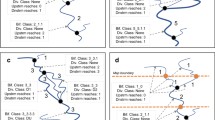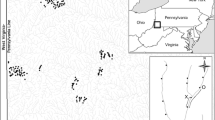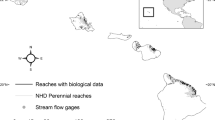Abstract
Stream classification frameworks are important tools for conserving aquatic resources. Yet despite their utility, most classification frameworks have not incorporated network connectivity. We developed and compared three biologically informed stream classification frameworks considering the effects of variables indexing local habitat and/or connectivity on stream fish communities. The first framework classified streams according to local environmental variables largely following the precedent set by previous stream classifications. The second framework classified streams according solely to network connectivity variables, while the third framework considered both local and connectivity variables. Using fish community data from 291 wadeable streams in South Carolina, USA, we used conditional inference tree analyses to identify either seven or eight discrete types of wadeable streams within each framework. Classifications were evaluated on their ability to describe community composition at a subset of sites not used in model training, and canonical correspondence analysis suggested that each framework performed similarly in describing overall community variation, with about 19% of variation explained. After accounting for the effects of biogeography and land use in our analytical approach, each classification explained a substantially higher amount of community variation with 46% of variation explained by our connectivity-informed classification and 42% explained by our locally informed classification. Classifications differed in their ability to describe elements of community structure; a classification incorporating connectivity predicted species richness better than the one that did not. This study ultimately addresses an important knowledge gap in the classification literature while providing broader implications for the conservation of aquatic organisms and their habitats.





Similar content being viewed by others
Data Availability
Data from this paper are available on request to co-author Mark Scott: scottm@sc.dnr.gov.
Code Availability
Code is available upon request to the corresponding author BKP.
References
Allan JD (2004) Landscapes and riverscapes: the influence of land use on stream ecosystems. Annu Rev Ecol Evol Syst 35:257–284
Angermeier PL (1995) Ecological attributes of extinction-prone species: loss of freshwater fishes of Virginia. Conserv Biol 9:143–158
Benda L, Poff NL, Miller D et al. (2004) The network dynamics hypothesis: how channel networks structure riverine habitats. Bioscience 54:413
Brenden TO, Wang L, Seelbach PW (2008) A river valley segment classification of Michigan streams based on fish and physical attributes. Trans Am Fish Soc 137:1621–1636
Brown BL, Swan CM (2010) Dendritic network structure constrains metacommunity properties in riverine ecosystems. J Anim Ecol 79:571–580
Brown BL, Swan CM, Auerbach DA et al. (2011) Metacommunity theory as a multispecies, multiscale framework for studying the influence of river network structure on riverine communities and ecosystems. J North Am Benthol Soc 30:310–327
Burcher CL, Valett HM, Benfield EF (2007) The land-cover cascade: relationships coupling land and water. Ecology 88:228–242
Cai Y, Zhang Y, Hu Z et al. (2019) Metacommunity ecology meets bioassessment: assessing spatio-temporal variation in multiple facets of macroinvertebrate diversity in human-influenced large lakes. Ecol Indic 103:713–721
Campbell Grant EH, Lowe WH, Fagan WF (2007) Living in the branches: Population dynamics and ecological processes in dendritic networks. Ecol Lett 10:165–175
Chessman BC, Fryirs KA, Brierley GJ (2006) Linking geomorphic character, behaviour and condition to fluvial biodiversity: implications for river management. Aquat Conserv 16:267–288
Cribari-Neto F, Zeileis A (2010) Beta regression in R. J Stat Softw 34(2):1–24
De Caceres M, Legendre P (2009) Associations between species and groups of sites: indices and statistical inference. Ecology 90(12):3566–3574
Dudgeon D, Arthington AH, Gessner MO et al. (2006) Freshwater biodiversity: importance, threats, status and conservation challenges. Biol Rev 81:163–182
Dufrene M, Legendre P (1997) Species assemblages and indicator species: the need for a flexible asymmetrical approach. Ecol Monogr 67:345–366
Everard M, Powell A (2002) Rivers as living systems. Aquat Conserv Mar Freshw Ecosyst 12:329–337
Fausch KD, Lyons J, Karr JR et al. (1990) Fish communities as indicators of environmental degradation. In: SM Adams (ed) Biological indicators of stress in fish. American Fisheries Society, Symposium 8, Bethesda, Maryland, pp 123–144
Fausch KD, Torgersen CE, Baxter CV et al. (2002) Landscapes to riverscapes: bridging the gap between research and conservation of stream fishes. Bioscience 52:483
Fick SE, Hijmans RJ (2017) Worldclim 2: new 1-km spatial resolution climate surfaces for global land areas. Intern J Climatol 37:4302–4315
Frimpong EA, Angermeier PL (2009) FishTraits: a database of ecological and life-history traits of freshwater fishes of the United States. Fisheries 34:487–495
Frissell CA, Liss WJ, Warren CE et al. (1986) A hierarchical framework for stream habitat classification: viewing streams in a watershed context. Environ Manag 10:199–214
Gorman OT (1986) Assemblage organization of stream fishes: the effect of adventitious streams. Am Nat 128:611–616
Graf WL (1999) Dam nation: a geographic census of American dams and their largescale hydrologic impacts. Water Resour Res 35:1305–1311
Grenouillet G, Pont D, Hérissé C (2004) Within-basin fish assemblage structure: the relative influence of habitat versus stream spatial position on local species richness. Can J Fish Aquat Sci 61:93–102
Hawkins CP, Norris RH, Gerritsen J et al. (2000) Evaluation of the use of landscape classifications for the prediction of freshwater biota: synthesis and recommendations. J North Am Benthol Soc 19:541–556
Higgins JV, Fitzhugh TW, Khoury ML et al. (2005) A freshwater classification approach for biodiversity conservation planning. Conserv Biol 19:432
Hitt NP, Angermeier PL (2008a) Evidence for fish dispersal from spatial analysis of stream network topology. J North Am Benthol Soc 27:304–320
Hitt NP, Angermeier PL (2008b) River-stream connectivity affects fish bioassessment performance. Environ Manag 42:132–150
Hitt NP, Angermeier PL (2011) Fish community and bioassessment responses to stream network position. J North Am Benthol Soc 30:296–309
Hoeinghaus DJ, Winemiller KO, Birnbaum JS (2007) Local and regional determinants of stream fish assemblage structure: Inferences based on taxonomic vs. functional groups. J Biogeogr 34:324–338
Hothorn T, Hornik K, Zeileis A (2006) Unbiased recursive partitioning: a conditional inference framework. J Comput Graph Stat 15(3):651–674
Hothorn T, Zeileis A (2015) partykit: a modular toolkit for recursive partytioning in R. J Mach Learn Res 16:3905–3909
Hugueny B, Oberdorff T, Tedesco PA (2010) Community ecology of river fishes: a large-scale perspective. In: Gido KB, Jackson DA (eds) Community ecology of stream fishes: concepts, approaches, and techniques. American Fisheries Society, Symposium 73, Bethesda, Maryland, p 29–62
Jones NE, Schmidt BJ (2017) Tributary effects in rivers: interactions of spatial scale, network structure, and landscape characteristics. Can J Fish Aquat Sci 74:503–510
Leathwick JR, Snelder T, Chadderton WL et al. (2011) Use of generalised dissimilarity modelling to improve the biological discrimination of river and stream classifications. Freshw Biol 56:21–38
Leibold MA, Holyoak M, Mouquet N et al. (2004) The metacommunity concept: a framework for multi-scale community ecology. Ecol Lett 7:601–613
Marion CA, Scott MC, Kubach KM (2015) Multiscale environmental influences on fish assemblage structure of south Atlantic coastal plain streams. Trans Am Fish Soc 144:1040–1057
Matthews WJ, Robison HW (1998) Influence of drainage connectivity, drainage area and regional species richness on fishes of the interior highlands in Arkansas. Am Midl Nat 139:1–19
McManamay RA, DeRolph CR (2019) A stream classification system for the conterminous United States. Sci Data 6:190017
Melles SJ, Jones NE, Schmidt BJ (2014) Evaluation of current approaches to stream classification and a heuristic guide to developing classifications of integrated aquatic networks. Environ Manag 53:549–566
Melles SJ, Jones NE, Schmidt BJ (2012) Review of theoretical developments in stream ecology and their influence on stream classification and conservation planning. Freshw Bio 57:415–434
Oksanen J, Blanchet FG, Friendly M et al. (2019) vegan: Community Ecology Package. R package Version 2.5-5
Omernik JM (1987) Ecoregions of the conterminous United States. Ann Assoc Am Geogr 77:118–125
Osborne LL, Wiley MJ (1992) Influence of tributary spatial position on the structure of warmwater fish communities. Can J Fish Aquat Sci 49:671–681
Poff NL, Allan JD, Bain MB et al. (1997) The natural flow regime. BioScience 47:769–784
Poole GC (2002) Fluvial landscape ecology: addressing uniqueness within the river discontinuum. Freshw Biol 47:641–660
Poos MS, Jackson DA (2012) Addressing the removal of rare species in multivariate bioassessments: the impact of methodological choices. Ecol Indic 18:82–90
R Core Team (2018) R: a language and environment for statistical computing. R Foundation for Statistical Computing, Vienna, Austria
Robin X, Turck N, Hainard A et al. (2011) pROC: an open-source package for R and S+ to analyze and compare ROC curves. BMC Bioinform 12:77
Rohde FC, Arndt RG, Foltz JW et al. (2009) Freshwater fishes of South Carolina. University of South Carolina Press, Columbia, South Carolina
Roset N, Grenouillet G, Goffaux D et al. (2007) A review of existing fish assemblage indicators and methodologies. Fish Manag Ecol 14:393–405
SCDNR—South Carolina Department of Natural Resources (2015) South Carolina State Wildlife Action Plan. http://dnr.sc.gov/swap/index.html
Schlosser IJ (1990) Environmental variation, life history attributes, and community structure in stream fishes implications for environmental management and assessment. Environ Manag 14:621–628
Schlosser IJ (1991) Stream fish ecology: a landscape perspective. Bioscience 41:704–712
Scott MC (2008) A probabilistic stream assessment to support freshwater conservation: preliminary results from the coastal plain. Proceedings of the 2008 South Carolina Water Resources Conference
Slawski TM, Veraldi FM, Pescitelli SM et al. (2008) Effects of tributary spatial position, urbanization, and multiple low-head dams on warmwater fish community structure in a Midwestern stream. N Am J Fish Manag 28:1020–1035
Sokal RR (1974) Classification: purposes, principles, progress, prospects. Science 185:1115–1123
Soranno PA, Cheruvelil KS, Webster KE et al (2010) Using landscape limnology to classify freshwater ecosystems for multi-ecosystem management and conservation. Bioscience 60:440–454
Tadaki M, Brierley G, Cullum C (2014) River classification: theory, practice, politics. WIREs Water 1(4):349–367
Taylor CA, Knouft JH, Hiland TM (2001) Consequences of stream impoundment on fish communities in a small North American drainage. Regul River 17:687–698
Thomson JR, Taylor MP, Brierley GJ (2004) Are river styles ecologically meaningful? A test of the ecological significance of a geomorphic river characterization scheme. Aquat Conserv 14(1):25–48
Tingley RW, Infante DM, MacKenzie RA et al. (2019) Identifying natural catchment landscape influences on tropical stream organisms: classifying stream reaches of the Hawaiian Islands. Hydrobiologia 826:67–83
Tonkin JD, Heino J, Altermatt F (2018) Metacommunities in river networks: the importance of network structure and connectivity on patterns and processes. Freshw Biol 63:1–5
Troia MJ, McManamay RA (2019) Biogeographic classification of streams using fish community- and trait-environment relationships. Divers Distrib 26(1):108–125
USGS—United States Geological Survey (2012) National Hydrography Dataset Plus—NHDPlusV2—NLCD2011 land use extension. Edition 2.10. Accessed May 2018
Wallace JB, Webster JR, Lowe LR (1992) High-gradient streams of the Appalachians. In: Hackney CT, Adams SM, Martin WH (eds) Biodiversity of the southeastern United States: aquatic communities. John Wiley & Sons, New York, p 122–191
Wang L, Brenden T, Cao Y et al. (2012) Delineation and validation of river network spatial scales for water resources and fisheries management. Environ Manag 50:875–887
Wang L, Infante D, Esselman P et al. (2011) A hierarchical spatial framework and database for the National River Fish Habitat Condition Assessment. Fisheries 36:436–449
Warren ML, Burr B, Walsh S (2000) Diversity, distribution, and conservation status of the native freshwater fishes of the southern United States. Fisheries 25(10):7–31
Wheaton JM, Bouwes N, McHugh P et al. (2018) Upscaling site‐scale ecohydraulic models to inform salmonid population‐level life cycle modeling and restoration actions—lessons from the Columbia River Basin. Earth Surf Processes 43(1):21–44
Zorn TG, Seelbach PW, Wiley MJ (2002) Distribution of stream fishes and their relationship to stream size and hydrology in Michigan’s Lower Peninsula. Trans Am Fish Soc 131:70–85
Acknowledgements
We thank the numerous SCDNR personnel who were involved in data collection for the South Carolina Stream Assessment, including Drew Gelder, Troy Cribb, William Poly, and Cathy Marion, as well as Clemson University students who contributed to the project, especially Alan Jones. Special thanks to Kyle Barrett of Clemson University for early comments that helped to shape this paper. This work was supported by the South Carolina Department of Natural Resources via the USFWS State Wildlife Grant number SC-T-F14AF01233. This work was also supported in part by the NIFA/USDA, under project number SC-1700531. This work represents technical contribution number 6929 of the Clemson Experiment Station.
Author information
Authors and Affiliations
Contributions
All authors contributed equally to this paper.
Corresponding author
Ethics declarations
Conflict of Interest
The authors declare that they have no conflict of interest.
Consent for Publication
All authors consent to publishing this paper in Environmental Management.
Additional information
Publisher’s note Springer Nature remains neutral with regard to jurisdictional claims in published maps and institutional affiliations.
Supplementary information
Rights and permissions
About this article
Cite this article
Denison, C.D., Scott, M.C., Kubach, K.M. et al. Incorporating Network Connectivity into Stream Classification Frameworks. Environmental Management 67, 291–307 (2021). https://doi.org/10.1007/s00267-020-01413-2
Received:
Accepted:
Published:
Issue Date:
DOI: https://doi.org/10.1007/s00267-020-01413-2




